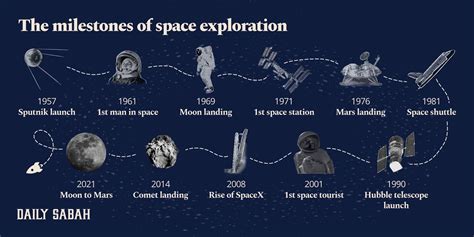The History and Evolution of Space Exploration

Delve into the history and remarkable evolution of space exploration, from its earliest conceptual visions to the groundbreaking achievements of the modern era. This blog post journeys through the dawn of spaceflight, highlighting the pivotal Space Race, a Cold War competition that fueled unprecedented advancements. We explore the iconic Apollo Program, celebrating humanity’s first steps on the Moon. Finally, we gaze towards the future, examining the next ambitious steps and the exciting possibilities that lie beyond Earth, shaping the ongoing narrative of our cosmic quest.
Early Visions And The Dawn Of Spaceflight
The allure of space has captivated humanity for centuries, with early visions of spaceflight deeply rooted in science fiction and imaginative literature. From Jules Verne’s prophetic novels to H.G. Wells’s tales of interplanetary travel, these narratives laid the groundwork for future generations of scientists and engineers. These stories, while fictional, sparked a collective dream of reaching beyond Earth’s confines. The history of space exploration is intertwined with these early aspirations, setting the stage for the technological advancements that would eventually make space travel a reality.
Before the advent of modern rocketry, theoretical physicists and mathematicians began to explore the possibilities of space travel. Konstantin Tsiolkovsky, a Russian schoolteacher, is often regarded as one of the founding fathers of astronautics. His work on rocket propulsion and the feasibility of using rockets for space travel laid the theoretical foundation for future engineers. Tsiolkovsky’s rocket equation, a pivotal concept, demonstrated the relationship between a rocket’s velocity, the exhaust velocity, and the mass ratio, providing a crucial tool for designing effective rockets.
| Visionary | Contribution | Impact |
|---|---|---|
| Jules Verne | Wrote about space travel in fiction. | Inspired future generations. |
| H.G. Wells | Explored interplanetary voyages. | Popularized space exploration concepts. |
| Konstantin Tsiolkovsky | Developed theoretical foundations for rocketry. | Provided essential mathematical principles. |
| Robert Goddard | Designed and built the first liquid-fueled rocket. | Advanced rocket technology significantly. |
The practical realization of spaceflight began with the pioneering work of Robert Goddard. An American physicist and engineer, Goddard designed, built, and launched the world’s first liquid-fueled rocket in 1926. This achievement marked a significant milestone, demonstrating the viability of liquid-fueled rockets for achieving higher altitudes and eventually escaping Earth’s gravity. Despite facing skepticism and limited funding, Goddard’s relentless pursuit of rocketry laid the groundwork for the sophisticated technologies that would later propel humanity into space.
The contributions of these early visionaries cannot be overstated. Their ideas, experiments, and relentless determination paved the way for the rapid advancements in rocketry and space technology that characterized the mid-20th century. These figures serve as the bedrock of the history of space exploration, their legacies enduring in every successful mission beyond our planet.
- Key Influences:
- Science Fiction Literature
- Theoretical Physics
- Konstantin Tsiolkovsky’s Rocket Equation
- Robert Goddard’s Liquid-Fueled Rockets
- Early Rocketry Experiments
Here’s the content section for your blog post about the history and evolution of space exploration. html
The History Of The Space Race: A Cold War Competition
The Space Race, a thrilling chapter in human history, was more than just a quest to explore the cosmos; it was a high-stakes competition between the United States and the Soviet Union during the Cold War. Fueled by ideological rivalry and national pride, both superpowers poured immense resources into their space programs, viewing space exploration as a crucial measure of technological and military prowess. This period witnessed incredible advancements in rocketry, satellite technology, and human spaceflight, forever changing our understanding of the universe and our place within it.
The competition spurred rapid innovation, with each nation striving to outdo the other in a series of groundbreaking achievements. From launching the first artificial satellite to sending the first human into space, the Soviets initially took the lead, shocking the world and sparking concerns in the United States about falling behind in science and technology. This prompted a massive increase in funding for American space programs and a renewed national focus on education in science and engineering.
| Date | Event | Nation |
|---|---|---|
| October 4, 1957 | Sputnik 1 Launch | Soviet Union |
| April 12, 1961 | First Human in Space (Yuri Gagarin) | Soviet Union |
| May 5, 1961 | First American in Space (Alan Shepard) | United States |
| July 20, 1969 | First Human on the Moon | United States |
The Space Race extended beyond mere technological achievements. It was a powerful tool for propaganda, showcasing the perceived superiority of each nation’s political and economic system. The success in space was seen as a symbol of national strength and a demonstration of scientific and engineering capabilities. The intense pressure to succeed also led to significant risks, pushing engineers and astronauts to their limits in the pursuit of ever-greater achievements.
Sputnik And Its Impact
The launch of Sputnik 1 by the Soviet Union in October 1957 sent shockwaves across the globe. This small, beeping satellite orbiting the Earth was a clear demonstration of Soviet technological capabilities and a wake-up call for the United States. Its impact was profound, leading to increased funding for science education and the establishment of NASA.
The Mercury Program
Project Mercury was the United States’ first human spaceflight program. Its primary goals were to orbit a crewed spacecraft around Earth, investigate human’s ability to function in space, and recover both spacecraft and crew safely. The program achieved these goals and paved the way for future, more ambitious missions.
The Vostok Program
The Soviet Union’s Vostok program achieved several significant milestones in the early years of space exploration. Most notably, it launched Yuri Gagarin into orbit, making him the first human in space. This accomplishment solidified the Soviet Union’s lead in the Space Race and inspired awe and admiration worldwide.
Despite the intense competition, the Space Race also laid the groundwork for future international cooperation in space exploration. As the Cold War tensions eased, the two nations began to collaborate on joint missions, recognizing the shared benefits of pooling resources and expertise. The legacy of the Space Race continues to shape our understanding of space and inspires ongoing exploration efforts today.
- Key Events:
- October 4, 1957: The Soviet Union launches Sputnik 1, the first artificial satellite.
- April 12, 1961: Yuri Gagarin becomes the first human in space, orbiting the Earth in Vostok 1.
- May 5, 1961: Alan Shepard becomes the first American in space, completing a suborbital flight in Freedom 7.
- February 20, 1962: John Glenn becomes the first American to orbit the Earth in Friendship 7.
- June 16, 1963: Valentina Tereshkova becomes the first woman in space, orbiting the Earth in Vostok 6.
- October 12, 1964: The Soviet Union launches Voskhod 1, the first spacecraft to carry more than one crew member.
- March 18, 1965: Alexei Leonov performs the first spacewalk during the Voskhod 2 mission.
Here’s the content section for your article, optimized for SEO and designed to fit seamlessly into your existing structure: html
Apollo Program: Landing Humans On The Moon
The Apollo Program stands as a monumental achievement in the history of space exploration. Driven by President John F. Kennedy’s ambitious goal to land a man on the Moon before the end of the 1960s, the program galvanized the United States and spurred unprecedented advancements in rocketry, materials science, and computing. It wasn’t just about reaching the Moon; it was about demonstrating technological superiority during the Cold War and inspiring a generation with the promise of what humanity could achieve.
The Apollo missions were not without their risks and challenges. The Apollo 1 disaster, in which astronauts Gus Grissom, Ed White, and Roger Chaffee perished during a pre-launch test, served as a stark reminder of the dangers inherent in spaceflight. This tragedy led to significant redesigns and safety improvements in the Apollo spacecraft, ultimately contributing to the program’s later success.
Here’s a table summarizing key Apollo missions:
| Mission | Launch Date | Crew | Notable Achievements |
|---|---|---|---|
| Apollo 8 | December 21, 1968 | Frank Borman, James Lovell, William Anders | First crewed orbit of the Moon. |
| Apollo 11 | July 20, 1969 | Neil Armstrong, Buzz Aldrin, Michael Collins | First humans to land on the Moon. |
| Apollo 13 | April 11, 1970 | James Lovell, Fred Haise, Jack Swigert | Successfully returned to Earth after an in-flight explosion. |
| Apollo 17 | December 7, 1972 | Eugene Cernan, Harrison Schmitt, Ronald Evans | Last crewed mission to the Moon. |
The culmination of the Apollo Program was, of course, Apollo 11 in July 1969. Neil Armstrong’s one small step became an iconic moment, broadcast around the world and forever etching the Apollo Program into the annals of human achievement. However, several hurdles had to be cleared before that point. The following are some of the challenges the Apollo program faced:
- Technical Complexity: Developing the Saturn V rocket and the Apollo spacecraft required solving unprecedented engineering challenges.
- Safety Concerns: Ensuring the safety of the astronauts during launch, flight, and landing was paramount.
- Resource Management: The program required massive financial and material resources.
- Navigational Accuracy: Precisely navigating to the Moon and back required advanced guidance systems.
- Environmental Hazards: Protecting astronauts from radiation and the harsh lunar environment was crucial.
Beyond the first landing, subsequent Apollo missions continued to explore the lunar surface, conducting scientific experiments and collecting valuable samples. These missions significantly advanced our understanding of the Moon’s composition, origin, and history. While the Apollo program concluded in 1972, its legacy continues to inspire future generations of scientists, engineers, and explorers, paving the way for continued advancements in space exploration and a renewed focus on returning to the Moon and venturing even further into the cosmos. The data and experience gathered during the Apollo missions remains invaluable as we contemplate future lunar bases and missions to Mars.
Future Of Exploration: Next Steps And Beyond Earth
As we reflect on the history of space exploration, it’s impossible not to look forward. The future holds immense potential, with advancements in technology and renewed global interest propelling us toward new frontiers. Current efforts are focused on sustainable space programs, international collaboration, and the development of innovative technologies that will enable us to travel farther and stay longer in space.
| Technology | Description | Potential Impact |
|---|---|---|
| Advanced Propulsion Systems | Including ion drives, nuclear propulsion, and fusion rockets. | Faster travel times, greater distances covered. |
| In-Situ Resource Utilization (ISRU) | Using resources found on other planets or moons to create fuel, water, and building materials. | Reduced mission costs, increased self-sufficiency. |
| Robotics and AI | Autonomous robots for exploration, construction, and maintenance. | Safer exploration, reduced reliance on human labor in hazardous environments. |
| Advanced Life Support Systems | Closed-loop systems that recycle air and water. | Longer duration missions, reduced need for resupply. |
One of the most exciting prospects is the establishment of a permanent human presence on the Moon and Mars. The Artemis program, for example, aims to return humans to the Moon by the mid-2020s and establish a sustainable lunar base. This base would serve as a stepping stone for missions to Mars and beyond. Private companies like SpaceX also have ambitious plans for Mars colonization, envisioning a self-sustaining human settlement on the Red Planet.
Actionable Steps:
- Invest in advanced propulsion technologies to reduce travel time.
- Develop robust In-Situ Resource Utilization (ISRU) techniques for self-sufficiency.
- Promote international collaboration to share resources and expertise.
- Establish clear ethical guidelines for space exploration and resource utilization.
- Support research into advanced life support systems for long-duration missions.
Asteroid mining represents another significant area of future exploration. Asteroids are rich in valuable resources, including water, precious metals, and rare earth elements. Mining these resources could not only provide materials for space-based manufacturing but also alleviate resource scarcity on Earth. Several companies are already developing technologies for asteroid mining, with plans to launch their first missions within the next decade.
Looking even further ahead, interstellar travel remains the ultimate frontier. While still largely theoretical, concepts such as warp drives, wormholes, and generation ships offer tantalizing possibilities for reaching other star systems. The challenges are immense, requiring breakthroughs in physics and engineering, but the potential rewards—discovering new worlds and perhaps even encountering extraterrestrial life—are equally profound. Space exploration is not just about reaching new destinations; it’s about expanding our understanding of the universe and our place within it.



